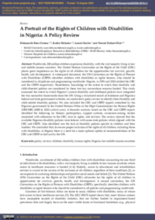Abstract:
Worldwide, 200 million children experience disability, with the vast majority living in low and middle-income countries. The United Nations Convention on the Rights of the Child (CRC) places great importance on the rights of all children for the opportunities for survival, growth, health, and development. A subsequent document, the UN Convention on the Rights of Persons with Disabilities (CRPD) identifies children with disabilities as rights bearers, who should be considered in all policies and programming worldwide.
Nigeria, in 1991 and 2010 ratified the CRC and the CRPD respectively. Nonetheless, knowledge of the extent to which their disability and child-directed policies are considered by these two key conventions remains limited. This study examined the extent to which Nigeria’s current disability and childhood policies have integrated the two normative frameworks from the UN. Using a structured search of databases and Nigerian federal and state government websites, the authors conducted a policy review to identify their disability and child-related disability policies. They also included the CRC and CRPD reports submitted by the Nigerian government to the United Nations Office of the High Commissioner for Human Rights (OHCHR) (2008 & 2010 cyclical year).
A thematic analysis, based on the CRC and CRPD report, identified the following six themes: participation, support systems, awareness-raising, factors associated with adherence to the CRC, laws & rights, and services. The review showed that the available Nigerian disability policies were federal, with some state policies which aligned with the CRC and CRPD. Also identified was the lack of disability policies specific to children and their families. The authors concluded that, to ensure proper inclusion of the rights of all children, including those with disabilities, in Nigeria there is a need for a more optimal uptake of recommendations of the CRC and CRPD as laid out by the UN.

